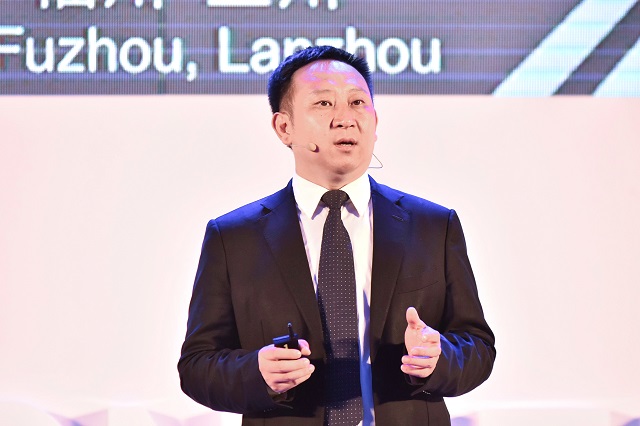Produits, solutions et services pour les entreprises
Akıllı Telefonlar, Bilgisayar&Tabletler, Giyilebilirler ve Daha Fazlası
[Shanghai, China, October 15, 2018] At HUAWEI CONNECT 2018, Huawei officially released IoT Cloud Service 2.0 and announced its IoT strategy (Provide IoT Infrastructure and Build up an Ecosystem). Through expanded connections, cloud services, and AI, Huawei is committed to building a more powerful industrial IoT and enabling industry digitalization.

Michael Ma, President of Huawei Cloud Core Network Product Line, releasing IoT Cloud Service 2.0 at HUAWEI CONNECT 2018
According to the Global Industry Vision (GIV) 2025 report released by Huawei, the number of connected devices will reach 100 billion in 2025. A large number of high-value connections will arise in the industry applications. Data generated from the awareness and perception of everything will be fully utilized by each industry to promote industrial IoT, improve industry efficiency, and boost industry upgrade.
The key requirements for building IoT infrastructure are to expand connections, enhance cloud services, and advance AI capabilities. Huawei aims to realize reliable inter-connectivity of everything, provide support for fast service rollout and global reachability through cloud services, and advance AI capabilities for industry partners to monetize their IoT applications. Huawei can realize this with the communication technology it has developed over the past 30 years.
Expanding Connections: Enabling Reliable Inter-connectivity of Everything
Connections are the foundation of IoT. To lay a secure foundation, Huawei not only aims to enlarge the number of connections, but also pursues manageable and controllable connections that can achieve continuous coverage, smooth evolution, security and reliability throughout the entire network. Huawei NB-IoT is characterized by its low power consumption, wide coverage, and large capacity, and it supports smooth evolution to 5G. Huawei builds a mature and open ecosystem and provides end-to-end security solutions covering chip-sets/OS, data transmission, and the IoT platform. The number of devices that currently connect to the Huawei IoT platform has reached 200 million worldwide, among which 90 million IoT devices are connected to China Telecom’s e-Surfing Cloud, and 1 million Smart City infrastructure devices are connected around the world.
Enhancing Cloud Services: Providing Ubiquitous IoT Services
In the future, the need for IoT connections will be so abundant; the key to enhancing IoT cloud services will be to make them available anytime, anywhere. Collaboration between OceanConnect IoT Platform and OceanConnect Edge makes full coverage, elastic services, unified management, service collaboration, and data collaboration possible, thereby extending IoT cloud services from the network center to the edge.
Advancing AI Capabilities: Reshaping IoT Values
The large amount of data obtained through connections requires intelligent analysis to generate value. Intelligence is the key technology for monetizing IoT. “Intelligence” is the algorithms at the network center and edge, and the perception of devices. Devices are to an intelligent system what the sensory organs are to a human being. Our eyes are the most important and effective tool for us to obtain information. Therefore, by standing in as the “eyes” for a fully connected, intelligent world, smart cameras will become a valuable tool to obtain information for industrial IoT, driving the industry to generate greater value. Huawei has invested heavily in AI chipsets, software-defined intelligent cameras, edge video analysis, and OceanConnect AI. By advancing AI capabilities, Huawei helps industry partners monetize their IoT applications.
At HUAWEI CONNECT 2017, Huawei released IoT Cloud Service 1.0 (DMP and AEP). To make it easier for industry customers to use Huawei’s IoT infrastructure capabilities (connectivity, cloud, and intelligence), Huawei then released IoT Cloud Service 2.0, which made three main improvements:
First, for industries that aspire to complete digital transformation, Huawei provides pre-integrated industry suites and platform cloud services, such as Connected Vehicle, Intelligent Transportation, Smart City, and Smart Campus. Industry partners can develop innovative applications more quickly and flexibly. More scenarios can be explored to identify new, valuable industry solutions that integrate AI capabilities.
Second, to expand connections across more industries, Huawei has released a lightweight cloud service — IoT Hub, a secure and reliable lightweight device management service that enables IoT devices to connect to the network in a simpler, more secure, and cost-effective way.
Third, to facilitate ecosystem partners, Huawei released the OceanConnect Market for product innovation, display, and trade with integrated development, rollout, and O&M tools.
Michael Ma, President of Huawei Cloud Core Network Product Line, stated: “Huawei hopes to join hands with partners to facilitate industrial IoT and expand the market by combining IoT and intelligence. Huawei and our partners can join to become the advocates and facilitators for a fully connected, intelligent world.”
HUAWEI CONNECT 2018, as Huawei's global annual flagship conference for the ICT industry, was held in Shanghai from October 10 to 12, 2018. This conference aims to build an open, cooperative, and shared platform that will work with customers to discuss how to seize new opportunities and create a smarter future.